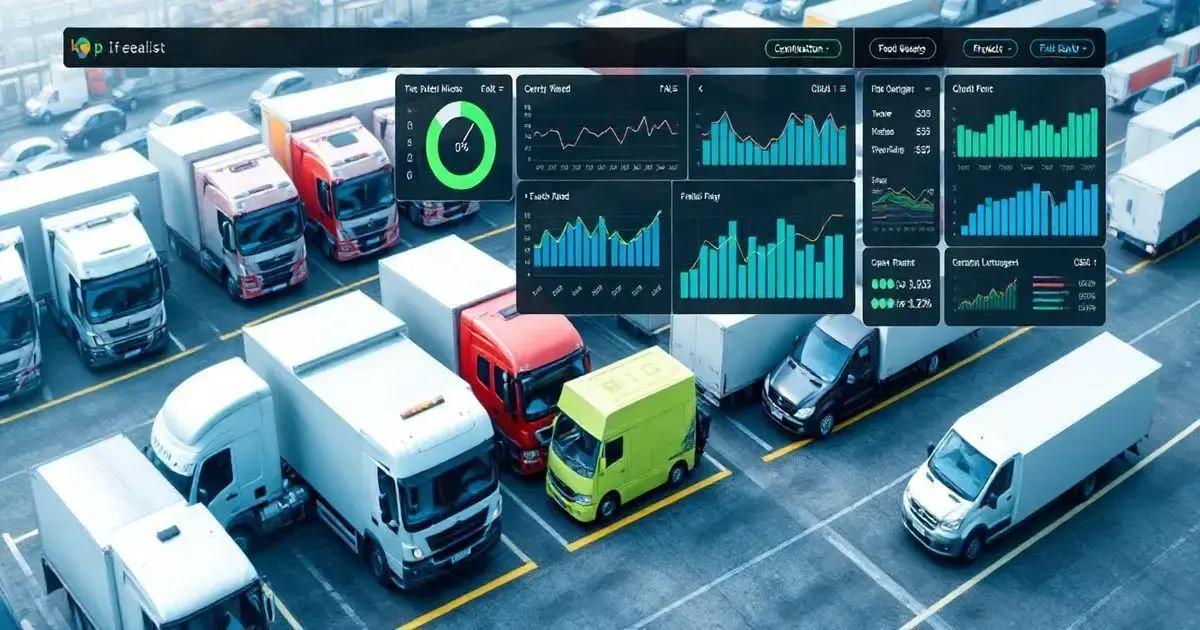Fleet Control Worksheet 7.0: Manage Your Fleet Efficiently Leave a comment
The Fleet Control Worksheet 7.0 is a specialized management tool for fleet operations, featuring dashboards for tracking kilometers driven, fuel consumption, and maintenance costs, along with detailed registration tracking, document management, travel logistics monitoring, tire management, and maintenance control, all aimed at optimizing fleet efficiency and reducing costs.
The Fleet Control Worksheet 7.0 is a robust tool designed to help businesses manage their fleet efficiently. With features for tracking maintenance, fuel consumption, and costs, it offers comprehensive control over your fleet operations, ensuring you stay ahead of potential issues.
Initial Dashboards Overview
The Fleet Control Worksheet 7.0 provides a comprehensive overview with its initial dashboards, allowing fleet managers to gain insights at a glance. These dashboards are crucial for tracking various metrics that influence the efficiency and effectiveness of fleet operations.
Some of the key components of the dashboards include:
- KM by Driver: This metric tracks the kilometers driven by each driver, helping to identify high performers and those who may need further training or guidance.
- KM per Vehicle: Analyzing the kilometers driven per vehicle helps in assessing vehicle usage and planning maintenance schedules more effectively.
- KM per Liter: This feature calculates fuel efficiency for each vehicle, ensuring that fuel costs are monitored closely and that drivers adhere to fuel-saving practices.
- KM per Trip: Monitoring the distance covered per trip can help identify routes that may require optimization for better fuel and time management.
- Average Consumption per Vehicle: Understanding fuel consumption on a per-vehicle basis allows for targeted interventions to improve efficiency.
- Average Consumption per Driver: This helps in holding drivers accountable for fuel usage and identifying best practices among the team’s drivers.
- Total General, Preventive and Corrective Maintenance: This overview shows a comprehensive view of all maintenance performed, allowing fleet managers to assess the overall health of their fleet.
- Maintenance Cost Average: By tracking average maintenance costs, businesses can identify trends and prepare budgets more accurately.
- Total Cost of Mechanical and Electrical Maintenance: It is essential to monitor these costs to ensure that they remain within acceptable limits.
- Total Tire Maintenance Cost: Keeping track of tire-related expenses helps manage budgets and improve tire life through better maintenance practices.
- Total Lubricant Cost: Monitoring lubricant expenses ensures that vehicles are properly maintained and reduces the risk of engine problems.
- Average Cost of Mechanical and Electrical Maintenance: This provides insights into routine maintenance costs and helps in budgeting and planning.
- Average Tire Maintenance Cost: Continuous assessment of tire expenses can lead to better purchasing decisions and improved tire management.
- Average Cost with Lubricants: This metric helps in tracking lubricant usage and ensuring that vehicles are operating optimally.
- Vehicles in Transit: Keeping tabs on vehicles that are currently on the road helps ensure accountability and timely deliveries.
- Tires in Transit: This feature ensures that tire inventory is accurately monitored, preventing shortages and ensuring replacements are timely.
- Delayed Vehicle Documents: Tracking any delays in vehicle documentation helps fleet managers address compliance issues promptly.
- Delayed Driver Documents: Ensuring that driver documentation is up-to-date is crucial for legal compliance and operational efficiency.
- Delayed Preventive Maintenance: Monitoring overdue maintenance tasks helps prevent costly repairs and enhances vehicle longevity.
- Total Cost Versus Shipping: This metric compares the overall operational costs against shipping revenues, providing a clear picture of profitability.
- Fuel, Maintenance and Other Costs: An aggregated view of all costs associated with running the fleet, allowing for better financial planning.
With these dashboards, fleet managers can quickly visualize critical data and make informed decisions that enhance fleet efficiency and reduce costs. The ability to track these metrics in real time can lead to significant improvements in fleet operations.

Registration Details
The Fleet Control Worksheet 7.0 includes a comprehensive registration system that enables fleet managers to maintain detailed records of both drivers and vehicles. This feature is essential for ensuring that all relevant information is readily available and easily accessible, facilitating better management and oversight of fleet operations.
Here’s a breakdown of the key registration components:
- Driver Registration: This section captures essential information about each driver, including their name, contact details, license number, and any training or certifications they hold. Keeping this information organized helps in managing driver assignments and ensuring compliance with regulatory requirements.
- Vehicle Type Registration: Each vehicle in the fleet needs to be categorized properly. This registration includes details such as the make, model, year, capacity, and identification number (VIN). Understanding the types of vehicles in the fleet helps in planning maintenance schedules and optimizing vehicle usage.
- Mechanical and Electrical Services Registry: This registry allows fleet managers to track all mechanical and electrical services performed on each vehicle. Documenting this information ensures that all service activities are accounted for and helps in maintaining a history of each vehicle’s performance and maintenance.
- Tree Service Registration: This feature allows for the documentation of tree services provided by the fleet, if applicable. This can include details about the nature of the service, the team involved, and the vehicle used.
- Lubricant Services Register: Tracking lubricant services helps in ensuring that vehicles receive the necessary maintenance to operate efficiently. Maintaining records of lubricant services can lead to better purchasing decisions and improved engine performance.
- Register of Workshops and Suppliers: This component maintains a database of all workshops and suppliers used for servicing the fleet. This allows fleet managers to evaluate service quality and manage relationships effectively.
- Expenditure Type Register: This register categorizes all expenses related to the fleet, making it easier to analyze costs and implement budget management strategies effectively.
- Refueling Station Registration: Keeping track of refueling stations is essential for managing fuel costs and ensuring that drivers have access to necessary resources during their routes.
- Fuel Type Register: Maintaining a record of the different fuel types used by the fleet is crucial for optimizing fuel purchases and ensuring compatibility with vehicle specifications.
By utilizing the registration features of the Fleet Control Worksheet 7.0, companies can streamline their fleet management processes, ensure compliance, and enhance overall operational efficiency. Having accurate and up-to-date records is vital for making informed decisions about vehicle and driver management.
Document Management Features
The Fleet Control Worksheet 7.0 incorporates a robust document management system that facilitates the organization and oversight of critical documentation related to both drivers and vehicles. This feature is crucial for ensuring compliance with legal requirements and enhancing operational efficiency.
Here’s a detailed look at the document management features:
Document Management Features
- Driver Document Control: This section allows fleet managers to manage all documents associated with each driver, including driving licenses, certifications, insurance documents, and more. By keeping these documents organized, managers can ensure that all drivers have the necessary credentials, reducing the risk of legal complications and enhancing safety.
- Vehicle Document Control: Similar to driver documents, this feature enables the tracking of all vital documents for each vehicle in the fleet. This includes registration papers, insurance details, and maintenance records. Having this information readily available ensures that all vehicles meet regulatory standards and are safe for operation.
Efficient document management allows for quick retrieval of information, ensuring that fleet managers can easily access critical documents when needed. This capability is essential for conducting audits, ensuring compliance during inspections, and facilitating smooth operations during day-to-day activities.
In addition, by digitizing and centralizing document storage, the Fleet Control Worksheet minimizes the risk of lost paperwork and enhances data security. Fleet managers can establish reminders for document renewals and track expiration dates, ensuring that all records are always current and valid.
Overall, the document management features of the Fleet Control Worksheet 7.0 streamline regulatory compliance and enhance the operational integrity of the fleet, ultimately contributing to safer and more efficient fleet management.

Travel Control Features
The Fleet Control Worksheet 7.0 is designed with effective travel control features that help fleet managers monitor and manage all aspects of vehicle journeys. These features not only enhance operational efficiency but also improve accountability among drivers and reduce costs associated with travel.
Here’s an overview of the key travel control features:
- Cargo Control Linked to Trips: This feature allows fleet managers to track cargo details associated with each trip. By having a clear overview of what cargo is transported, managers can ensure that shipments are delivered on time and that any potential issues are swiftly addressed.
- Vehicle Control: Keeping tabs on which vehicles are assigned to specific trips helps in managing the fleet effectively. This feature allows for real-time monitoring of vehicle usage and helps optimize route planning based on vehicle availability.
- Driver Control: This ensures that each driver is monitored throughout their journey. It helps in tracking their whereabouts and performance, thereby enabling managers to ensure compliance with safety regulations and company policies.
- Supply Control: Monitoring supplies needed during travel is essential for ensuring that drivers have everything they need on the road. This feature helps in managing inventory and ensuring that all necessary supplies are stocked in vehicles.
- Control of All Travel Expenses: The worksheet allows for meticulous tracking of all expenses incurred during travel, including fuel costs, tolls, and other operational expenses. This helps in analyzing travel costs and implementing strategies for budget optimization.
The travel control features of the Fleet Control Worksheet 7.0 provide invaluable insights into fleet operations, helping managers make data-driven decisions that enhance productivity and reduce costs. By leveraging these features, companies can ensure that their fleet operates smoothly and efficiently, ultimately leading to better service delivery and customer satisfaction.
Tire Control Management
The Fleet Control Worksheet 7.0 includes comprehensive tire control management features that are essential for maintaining the efficiency and safety of vehicles in the fleet. Proper tire management not only extends the life of tires but also ensures optimal fuel efficiency and enhances overall vehicle performance.
Here’s a closer look at the key components of tire control management:
Tire Control Management
- Identification for Each Tire: Each tire in the fleet is assigned a unique identification number. This allows for easy tracking of tire history, usage, and conditions, ensuring that no tire is overlooked during maintenance checks.
- Tire Change Schedule by KM: The worksheet provides a scheduled maintenance plan based on kilometers driven. This proactive approach helps fleet managers to replace tires at recommended intervals, reducing the risk of tire failure and enhancing safety on the road.
- Signal of How Much KM is Left to Change the Tire: An important feature that alerts managers about the remaining kilometers before a tire is due for replacement. This helps in planning tire changes ahead of time, minimizing downtime and ensuring that vehicles are always roadworthy.
- Status per Action: This feature tracks the status of each tire based on actions such as allocation to a vehicle, removal from a vehicle, scrapping, or ongoing maintenance. Keeping track of these actions helps in making informed decisions about tire utilization and replacement.
By incorporating these tire control management features, the Fleet Control Worksheet 7.0 enables fleet managers to optimize tire performance, reduce costs associated with premature tire wear, and improve safety for drivers and cargo alike. Overall, effective tire management is a crucial aspect of maintaining a productive and efficient fleet.

Maintenance Control Specifications
The Fleet Control Worksheet 7.0 is equipped with robust maintenance control specifications designed to ensure that all vehicles in the fleet are kept in optimal condition. Regular maintenance is vital for enhancing the safety, reliability, and longevity of fleet vehicles.
Here’s a detailed look at the key components of maintenance control:
Maintenance Control Specifications
- Corrective and Preventive Maintenance Type: This feature allows fleet managers to categorize maintenance tasks into corrective (unplanned repairs) and preventive (scheduled maintenance) types. By tracking both, managers can ensure that vehicles are not only repaired when necessary but also serviced regularly to prevent issues.
- Maintenance by Vehicle: Each vehicle’s maintenance record is tracked individually, allowing fleet managers to understand the specific needs and history of every vehicle. This ensures that maintenance schedules are adhered to based on the individual vehicle’s usage and condition.
- Maintenance by Mechanical and Electrical Type, Tire and Lubricants: The worksheet provides specifications for various types of maintenance, including mechanical, electrical, tire-related, and lubricant maintenance. This holistic approach ensures that all aspects of vehicle care are covered, optimizing performance and reducing the likelihood of breakdowns.
- Maintenance Cost: Keeping track of maintenance costs is crucial for budget management. This feature allows fleet managers to analyze expenses associated with different types of maintenance, helping to identify trends and areas for cost reduction.
- Preventive Maintenance Schedule: The worksheet enables the development of a preventive maintenance schedule that outlines when each vehicle should undergo service. This proactive approach is essential for preventing major issues and extends the life of the vehicles.
- Preventive Maintenance Signal: Alerts and signals notify fleet managers when preventive maintenance is due, ensuring that no vehicles are overlooked. This helps maintain operational efficiency and safety.
- Status by: Scheduled, Accomplished and Delayed: This feature allows tracking of the status of maintenance tasks, categorizing them into scheduled, completed, or delayed. This transparency helps in managing workloads and prioritizing tasks effectively.
By leveraging the maintenance control specifications of the Fleet Control Worksheet 7.0, fleet managers can ensure a high level of vehicle reliability and safety. Regular maintenance not only reduces the risk of unexpected breakdowns but also leads to significant cost savings over time by avoiding major repairs.
Conclusion
The Fleet Control Worksheet 7.0 stands out as an essential tool for any organization managing a fleet of vehicles.
With its comprehensive features ranging from maintenance control to tire management and travel oversight, this worksheet empowers fleet managers to operate efficiently and effectively.
By systematically tracking driver and vehicle registrations, maintaining robust document management, and implementing a proactive approach to maintenance, businesses can not only enhance the safety and reliability of their fleet but also significantly reduce operational costs.
The structured dashboards provide valuable insights, allowing for informed decision-making that can directly impact profitability.
Ultimately, investing in the Fleet Control Worksheet 7.0 ensures that your fleet is well-managed, compliant with regulations, and primed for peak performance, making it an invaluable asset for any fleet management strategy.
FAQ – Frequently Asked Questions about Fleet Control Worksheet 7.0
What is the purpose of the Fleet Control Worksheet 7.0?
The Fleet Control Worksheet 7.0 helps manage fleet operations efficiently by tracking vehicle maintenance, driver details, travel logistics, and costs associated with fleet management.
How can I track tire maintenance using this worksheet?
The worksheet includes features for tire identification, change schedules based on kilometers driven, and alerts for when tires need to be replaced.
Is it possible to monitor travel expenses with the Fleet Control Worksheet 7.0?
Yes, it allows for meticulous tracking of all travel-related expenses, including fuel costs, tolls, and any other operational costs incurred during trips.
How does the document management feature work?
The document management feature enables the organization of critical documents for both drivers and vehicles, ensuring easy access and compliance with legal requirements.
Can I customize the maintenance schedule for different vehicles?
Absolutely! The worksheet allows fleet managers to create customized preventive maintenance schedules tailored to each vehicle’s usage and specific maintenance needs.
What type of support is available if I encounter issues with the worksheet?
Support is typically provided via email or chat, ensuring you can get assistance with any issues or questions related to the functionality of the Fleet Control Worksheet 7.0.

